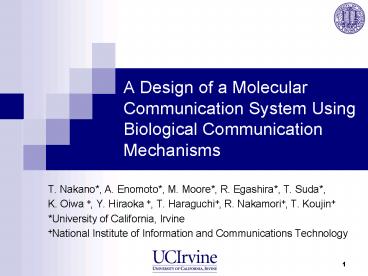A Design of a Molecular Communication System Using Biological Communication Mechanisms - PowerPoint PPT Presentation
1 / 30
Title:
A Design of a Molecular Communication System Using Biological Communication Mechanisms
Description:
1. A Design of a Molecular Communication System Using Biological Communication Mechanisms ... Amplifier. Switch. Engineering the network components using cells ... – PowerPoint PPT presentation
Number of Views:2622
Avg rating:3.0/5.0
Title: A Design of a Molecular Communication System Using Biological Communication Mechanisms
1
A Design of a Molecular Communication System
Using Biological Communication Mechanisms
- T. Nakano, A. Enomoto, M. Moore, R. Egashira,
T. Suda,K. Oiwa , Y. Hiraoka , T. Haraguchi,
R. Nakamori, T. KoujinUniversity of
California, IrvineNational Institute of
Information and Communications Technology
2
Outline
- Nanomachine communication
- Nanomachines
- Our approach
- Molecular communication
- Example systems
- Conclusions
3
Nanomachine Communication
- Goal
- Achieve communication between nanomachines
- Nanomachine nano-scale or molecular scale
objects that are capable of performing simple
tasks
Figure Protonic Nanomachin Project, Prof.
Namba at Osaka University http//www.npn.jst.go.j
p/index.html
4
Nanomachines
- Biological nanomachines
- Dynein
- Molecular motors that walk along microtubule in a
cell - F1ATPase
- Synthesizes ATP (energy) by using an influx of
protons to rotate - Bacterium
- Swims toward the chemicals (e.g, food) using
flagellum
Bacterium
Figures Alberts, Molecular Biology of the Cell
Dynein
F1ATPase
5
Nanomachines
- Biological nanomachines
- logic gates made of biological components (e.g,
enzymes or bacteria) - If both substrate and effector exist, product
produced - If no effector or no substrate, substrate remains
unchanged
S
P
C
6
Nanomachines
- Artificial nanomachines
- Nickel propeller
- Size 0.75 - 1.5 um
- Micron motor
- Size 100 um in diameter
- 10,000 rpm
Engineering Issues in the fabrication of a
hybrid nano-propeller system powered by F1-ATPase
MEMS/NEMS http//www.fujita3.iis.u-tokyo.ac.jp/
7
Our Approach
- Use communication mechanisms that biological
systems use - Intracellular communication
- Intercellular communication
8
Intracellular Communication
- Transport materials using molecular motors within
a cell
Vesicles transported by molecular motors
Microtubules
9
Intercellular communication
- Cells coordinate through calcium signaling
J. Cell Biol. Jørgensen et al. 139 (2) 497, 1997
10
Applications
- Pinpoint drug delivery
- To deliver drug to (targeted) cancer cells
- Molecular computing
- Coordination among distributed logical gates
ltBio nano-machine communicationgt
S
P
C
AND
OR
AND
11
Outline
- Nanomachine communication
- Nanomachines
- Our approach
- Molecular communication
- Example systems
- Conclusions
12
Molecular Communication
- Sending and receiving of molecules as an
information carrier
13
- Make nanomachines communicate using communication
mechanisms in living organisms - Senders/receivers biological nanomachines
- Communication carrier molecules (e.g.,
proteins, ions, DNAs) - Communication distance nano/micro scale
- A receiver (chemically/physically) reacts to
incoming molecules
14
5. Decoding
1. Encoding
4. Receiving
2. Sending
3. Propagation
Senders (nanomachines)
Receivers (nanomachines)
15
Key System Components
- A sender
- Molecule generation
- Molecule encoding
- Molecule emission
- Propagation
- Molecule loading at a sender
- Direction control
- Molecule unloading at a receiver
- Molecule recycling
16
- A receiver
- Molecule reception
- Molecule decoding
- Molecule decomposition or recycling
17
System Characteristics
- We want the system to be
- Autonomous (i.e., no human control)
- Closed (i.e., no energy supply from outside)
- Recycling (of carrier molecules and information
molecules) - Other system characteristics
- Probabilistic behavior
- Many to many communication
- Slow delivery of molecules
18
Two Example Systems
- Molecular Communication
- Using a cellular network
- Using molecular motors
19
Example 1 Molecular Communication Based on a
Cellular Network
Network of Biological Cells
Encoding information on calcium waves
Engineering the network components using cells
Decoding information from calcium waves
Various cellular responses (e.g., contraction,
secretion, growth, death)
Amplifier
Switch
20
1-n communication (broadcasting medium)
21
1-1 communication
22
Gap Junctions
- Nanoscale protein channels connecting two
adjacent cells - Allowing small molecules to be shared among
cells, enabling coordinated action of the cells
23
Example Networking
- Filtering signals
Signal X is more permeable to channels formed
between the cells
24
Example Networking
- Filtering signals
Signal Y is more permeable to channels formed
between the cells
25
Example Networking
- Switching the direction of signaling
26
Example Networking
- Switching the direction of signaling
Phosphorylation of channels increases/decreases
permeability of the channels.
27
Example 2 Molecular Communication Using
Molecular Motors
- Nanomachines communicate using molecular motors.
- Molecules are transported by molecular motors
that walk over a network of rail molecules.
28
Outline
- Nanomachine communication
- Nanomachines
- Our approach
- Molecular communication
- Example systems
- Conclusions
29
Research Issues
- Developing applications that require
communication among bio nanomachines - System designs using biological communication
mechanisms - Autonomous, closed, recycling system
- Various system components
- Creating new information and coding concepts
and models - Various approaches
- Feasibility test through experiments
- Theoretical modeling and analysis
- Simulations
30
Conclusions
- Molecular Communication
- New paradigm
- Need a lot of research
- Integrating nano technology, bio technology and
computer science































